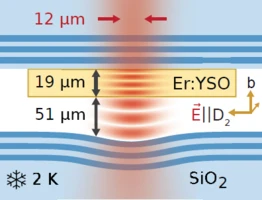Our group follows two complementary approaches to realize quantum networks with individual erbium ions: Nanophotonic and Fabry-Perot resonators. In the latter, the light–matter interaction is enhanced by placing the emitters between highly reflective mirrors. To maximize the Purcell enhancement, we assemble resonators with minimal mode volume and very high quality factors.

This is achieved by fabricating mirrors with spherical depressions of ~150 µm radius of curvature using laser ablation and applying commercial dielectric coatings. The resulting finesse exceeds 10⁵. We then integrate erbium-doped membranes polished down to thicknesses of 10–20 µm with sub-nanometer surface roughness. This near-atomically flat surface minimizes scattering losses and supports high optical quality factors. In addition, the cavity length is actively stabilized to within ~1 picometer to match the narrow emission lines of erbium ions [1].
With these resonators, we have demonstrated up to a 110-fold reduction in the excited-state lifetime while maintaining the optical coherence up to the liftime limit. This allows for efficient and rapid photon generation, a key requirement for scalable quantum networks [2, 3]. To be able to control many qubits by spectral multiplexing, we co-dope the crystals with europium to tailor the inhomogeneous broadening. Using this approach, we have spectrally resolved over 360 individual erbium dopants in a single resonator—each of which can act as an individually addressable qubit. Long-term measurements reveal exceptional spectral stability below 0.2 MHz, enabling coherent, frequency-multiplexed control [2, 3].
In this system, we further studied the superhyperfine interaction with yttrium nuclear spins in the proximity of each erbium ion. We obtained detailed insights on the structure of dense nuclear-spin environments, which enables novel approaches to the detection and coherent control of individual nuclear spins in solids [4]. Current efforts in this system focus on understanding and mitigating spectral diffusion.
Together, these advances pave the way toward robust, multiplexed quantum network nodes based on erbium dopants that operate directly at telecommunication wavelengths.
[1] B. Merkel et al., Coherent and Purcell-Enhanced Emission from Erbium Dopants in a Cryogenic High-𝑄 Resonator, Phys. Rev. X 10, 041025 (2020)
[2] A. Ulanowski et al., Spectral multiplexing of telecom emitters with stable transition frequency., Science Advances. 8, eabo4538 (2022)
[3] A. Ulanowski et al., Spectral Multiplexing of Rare-Earth Emitters in a Co-Doped Crystalline Membrane, Adv. Optical Mater., 12, 2302897 (2024)
[4] A. Ulanowski et al., Cavity-Enhanced Spectroscopy of Individual Nuclear Spins in a Dense Bath, PRX Quantum 6, 020344 (2025)